Comparison of Four Methods for Borehole Heat Exchanger Sizing Subject to Thermal Response Test Parameter Estimation
Abstract
:1. Introduction
2. Heat Transfer Models for TRTPE
2.1. Heat Transfer Models
2.1.1. ILS
2.1.2. ICS
2.1.3. FLSN
2.1.4. FLSA
2.1.5. FLSCC
2.1.6. DST
2.2. Parameter Estimation Methods
3. TRT Experimental Data and the Results of PE
3.1. Experimental Data from the Thermal Response Test
3.2. Parameter Estimation Results
4. Comparison of the Time Evolution of Mean Fluid Temperatures for a Single Borehole
5. Sizing Methods for BHE
5.1. IGSHPA Method
5.2. ASHRAE Method
5.3. FLSCC-Based Method
5.4. DST-Based Method
5.5. Summary of the Sizing Methods
6. Comparison of Borehole Design Lengths for a Bore Field
6.1. Parameter Settings for Comparison Runs
6.1.1. Building Thermal Loads
6.1.2. Thermal Interference Effect
6.1.3. Temperatures
6.1.4. Heat Pump Characteristics
6.1.5. Equipment On/Off Cycling Effect
6.1.6. Other Effects
6.1.7. Summary of Input Parameters and Values for Comparison Runs
6.2. Results of Predicted Borehole Lengths
6.2.1. Variation in Borehole Design Length Subject to PE
6.2.2. Comparison of Borehole Lengths Based on Four Sizing Methods
7. Conclusions
Author Contributions
Funding
Acknowledgments
Conflicts of Interest
Nomenclature
| B | Borehole spacing, m; |
| cs | Soil specific heat capacity, J·kg−1·K−1; |
| Cf | Fluid specific heat, J·kg−1·K−1; |
| COPc | Coefficient of performance for cooling mode, --; |
| COPh | Coefficient of performance for heating mode, --; |
| dp | Depth of thermal penetration, m; |
| E | Total heat stored in a cylindrical region, J; |
| Fc | Run fraction for cooling mode, --; |
| Fh | Run fraction for heating mode, --; |
| Fsc | Short-circuit heat loss factor, --; |
| g | g function, --; |
| glt | Long-term response factor g function, --; |
| gst | Short-term response factor g function, --; |
| G | G factor, --; |
| H | Borehole depth, m; |
| k▽ | Geothermal gradient, °C·m−1; |
| K0 | Modified Bessel functions of the second kind of order 0; |
| K1 | Modified Bessel functions of the second kind of order 0; |
| Lave | Average length of design length for each sizing method, m; |
| Lbase | Design length benchmark for comparison subject to parameter estimation, m; |
| Lc | Required design length for cooling mode, m; |
| Lh | Required design length for heating mode, m; |
| Flow rate, m3·s−1; | |
| PLFm | Part load factor, --; |
| ql | Heat transfer rate, W·m−1; |
| Qa | Net annual average heat transfer to ground, W; |
| Qc | Design load for cooling mode, W; |
| Qh | Design load for heating mode, W; |
| rb | Borehole radius, m; |
| ri | Pipe inside radius, m; |
| ro | Pipe outside radius, m; |
| roe | Equivalent pipe radius, m; |
| Rb | Borehole thermal resistance, K·m·W−1; |
| Rga | Effective thermal resistances of ground to annual pulse, K·m·W−1; |
| Rgd | Effective thermal resistances of ground to peak daily pulse, K·m·W−1; |
| Rgm | Effective thermal resistances of ground to monthly pulse, K·m·W−1; |
| Rp | Pipe thermal resistance, K·m·W−1; |
| Rs | Soil thermal resistance, K·m·W−1; |
| T0 | Undisturbed ground temperature, °C; |
| T0s | Ground surface temperature at z = 0, °C; |
| Tair | Air temperature, °C; |
| Tam | Amplitude of temperature oscillations, °C; |
| b | Mean borehole wall temperature, °C; |
| Tbase | Mean fluid temperature calculated by base parameter estimation result, °C; |
| f | Mean fluid temperature, °C; |
| Tin,hp | Fluid temperature entering the heat pump, °C; |
| Tout,hp | Fluid temperature leaving the heat pump, °C; |
| Tin,BHE | Fluid temperature entering the borehole heat exchanger, °C; |
| Tout,BHE | Fluid temperature leaving the borehole heat exchanger, °C; |
| TL | Minimum heat pump entering fluid temperature, °C; |
| TH | Maximum heat pump entering fluid temperature, °C; |
| Tgs | Contribution portion of ground surface temperature, °C; |
| Tm | Annual mean ground surface temperature, °C; |
| Tp | Penalty temperature, °C; |
| T▽ | Contribution portion of undisturbed ground temperature, °C; |
| VDST | Storage volume, m3; |
| Greek letters | |
| αs | Soil thermal diffusivity, m²·s−1; |
| εRE,PE | Relative difference of mean borehole temperature subject to parameter estimation, --; |
| εRE, M, | Relative difference of average length subject to sizing method, --; |
| φ | Undisturbed ground temperature in the vertical direction, °C; |
| γ | Euler’s constant; |
| κs | Soil thermal conductivity, W·m−1·K−1; |
| ρs | Soil density, kg·m−3; |
| τa | Operation time of annual pulse, s; |
| τd | Operation time of daily pulse, s; |
| τm | Operation time of monthly pulse, s; |
| τmin | Time boundary of unsteady state, s; |
| τn | Simulation period, s; |
| τpd | Period of temperature oscillations, s; |
| τss | Time boundary of steady state, s; |
| υf | Flow velocity, m·s−1; |
| ω | Angular frequency, rad·s−1; |
| ∆τ | Phase constant, s; |
| ψ | Ground surface temperature, °C; |
| Abbreviations | |
| BHE | Borehole heat exchanger |
| COP | Coefficient of performance |
| DST | Duct ground heat storage model |
| EFT | Entering fluid temperature |
| FLS | Finite line source model |
| FLSA | Finite line source model with analytical solution |
| FLSCC | Finite line source model considering complex initial and boundary conditions |
| FLSN | Finite line source model with numerical solution |
| GCHP | Ground coupled heat pump |
| ICS | Infinite cylinder source model |
| IGSHPA | International Ground Source Heat Pump Association |
| ILS | Infinite line source model |
| RMSE | Root-mean-square error |
| SSE | Error sum of squares |
| TRT | Thermal response test |
References
- Ball, D.A.; Fischer, R.D.; Hodgett, D.L. Design methods for ground-source heat pumps. ASHRAE Trans. 1983, 89, 416–440. [Google Scholar]
- ASHRAE. ASHRAE Handbook—HVAC Applications; Chapter 34. Geothermal Energy; American Society of Heating, Refrigerating and Air Conditioning Engineers (ASHRAE): Atlanta, GA, USA, 2011. [Google Scholar]
- Kavanaugh, S.P.; Rafferty, K. Ground-source Heat Pumps—Design of Geothermal System for Commercial and Institutional Buildings; ASHRAE: Atlanta, GA, USA, 1997. [Google Scholar]
- IGSHPA. Ground Source Heat Pump Residential and Light Commercial: Design and Installation Guide; Oklahoma State University: Stillwater, OK, USA, 2009. [Google Scholar]
- Eskilson, P. Thermal Analysis of Heat Extraction Boreholes. Ph.D. Thesis, University of Lund, Lund, Switzerland, 1987. [Google Scholar]
- Hellström, G. Ground Heat Storage Thermal Analyses of Duct Storage System I. Theory. Ph.D. Thesis, University of Lund, Lund, Switzerland, 1991. [Google Scholar]
- Pahud, D.; Hellström, G. The new duct ground heat model for TRNSYS. In Seminar 49 Physical Models for Thermal Energy Stores; Eindhoven University of Technology: Eindhoven, The Netherlands, 1996. [Google Scholar]
- Yang, H.; Cui, P.; Fang, Z. Vertical-borehole ground-coupled heat pumps: A review of models and systems. Appl. Energy 2010, 87, 16–27. [Google Scholar] [CrossRef]
- Rainieri, S.; Bozzoli, F.; Pagliarini, G. Modeling approaches applied to the thermal response test: A critical review of the literature. HVAC&R Res. 2011, 17, 977–990. [Google Scholar]
- Thornton, J.W.; McDowell, T.P.; HuBHEs, P.J. Comparison of practical vertical ground heat exchanger sizing methods to a Fort Polk datamodel benchmark. ASHRAE Trans. 1997, 8, 675–683. [Google Scholar]
- Shonder, J.A.; Baxter, V.; Thornton, J.; HuBHEs, P. A comparison of vertical ground heat exchanger software for commercial applications. ASHRAE Trans. 2000, 106, 831–842. [Google Scholar]
- Kurevija, T.; Vulin, D.; Krapec, V. Effect of borehole array geometry and thermal interferences on ground source heat pump system. Energy Convers. Manag. 2012, 60, 134–142. [Google Scholar] [CrossRef]
- Cullin, J.R.; Spitler, J.D.; Montagud, C. Validation of vertical ground heat exchanger design methodologies. Sci. Technol. Built Environ. 2015, 21, 137–149. [Google Scholar] [CrossRef]
- Staiti, M. The Sizing of Borehole Heat Exchangers for Ground Source Heat Pumps: A Comparison Between Two Methods. Master’s Thesis, Politecnico di Milano, Milan, Italy, 2014. [Google Scholar]
- Beier, R.A. Vertical temperature profile in ground heat exchanger during in-situ test. Renew. Energy 2011, 36, 1578–1587. [Google Scholar] [CrossRef]
- Conti, P. Dimensionless Maps for the Validity of Analytical Ground Heat Transfer Models for GSHP Applications. Energies 2016, 9, 890. [Google Scholar] [CrossRef]
- Zarrella, A.; Emmi, G.; Graci, S.; De Carli, M.; Cultrera, M.; Santa, G.; Galgaro, A.; Bertermann, D.; Müller, J.; Pockelé, L.; et al. Thermal Response Testing Results of Different Types of Borehole Heat Exchangers: An Analysis and Comparison of Interpretation Methods. Energies 2017, 10, 801. [Google Scholar] [CrossRef]
- Urchueguía, J.; Lemus-Zúñiga, L.; Oliver-Villanueva, J.; Badenes, B.; Pla, M.; Cuevas, J. How Reliable Are Standard Thermal Response Tests? An Assessment Based on Long-Term Thermal Response Tests Under Different Operational Conditions. Energies 2018, 11, 3347. [Google Scholar] [CrossRef]
- Morgensen, P. Fluid to Duct Wall Heat Transfer in Duct System Heat Storages. In International Conference on Surface Heat Storage in Theory and Practice; Swedish Council for Building Research: Stockholm, Switzerland, 1983; pp. 652–657. [Google Scholar]
- Zhang, C.; Guo, Z.; Liu, Y.; Cong, X.; Peng, D. A review on thermal response test of ground-coupled heat pump systems. Renew. Sustain. Energy Rev. 2014, 40, 851–867. [Google Scholar] [CrossRef]
- Ingersoll, L.R.; Plass, H.J. Theory of the ground pipe heat source for heat pump. Heat. Pip. Air Cond. 1948, 20, 119–122. [Google Scholar]
- Carslaw, H.S.; Jaeger, J.C. Conduction of Heat in Solids, 2nd ed.; Oxford University Press: Oxford, UK, 1959; p. 510. [Google Scholar]
- Ingersioll, L.; Zobel, O.J.; Ingersoll, A.C. Heat Conduction: With Engineering Geological and Other Applications; Mc Graw-Hill: New York, NY, USA, 1954; p. 325. [Google Scholar]
- Cimmino, M.; Bernier, M.; Adams, F. A contribution towards the determination of g-functions using the finite line source. Appl. Therm. Eng. 2013, 51, 401–412. [Google Scholar] [CrossRef]
- Yavuzturk, C. Modeling of Vertical Ground Loop Heat Exchangers for Ground Source Heat Pump Systems. Ph.D. Thesis, Oklahoma State University, Stillwater, OK, USA, 1999. [Google Scholar]
- Bandos, T.V.; Montero, Á.; Fernández, E.; Santander, J.L.G.; Isidro, J.M.; Pérez, J.; De Córdoba, P.J.F.; Urchueguíab, J.F. Finite line-source model for borehole heat exchangers: Effect of vertical temperature variations. Geothermics 2009, 38, 263–270. [Google Scholar] [CrossRef]
- Zhang, X.; Zhang, T.; Jiang, Y.; Li, B. Improvement on an analytical finite line source model considering complex initial and boundary conditions: Part 1, model development and validation. Energy Build. 2019, 198, 1–10. [Google Scholar] [CrossRef]
- Bernier, M.A. Ground-coupled heat pump system simulation. ASHRAE Trans. 2001, 107, 605–616. [Google Scholar]
- Baudoin, A.E. Stockage Intersaisonnier de Chaleur Dans le sol par Batterie D’echangeurs Baionnette Verticaux: Modele de Predimensionnement. Ph.D. Thesis, Université de Reims, Reims, France, 1988. [Google Scholar]
- Maestre, I.R.; Gallero, F.J.G.; Gómez, P.Á.; Pérez-Lombard, L. A new RC and g-function hybrid model to simulate vertical ground heat exchangers. Renew. Energy 2015, 78, 631–642. [Google Scholar] [CrossRef]
- Kusuda, T.; Achenbach, P.R. Earth temperature and thermal diffusivity selected stations in the United States. ASHRAE Trans. 1965, 71, 61–76. [Google Scholar]
- Witte, H.J.L. Advances in geothermal response testing. Therm. Energy Storage Sustain. Energy Consum. 2007, 234, 177–192. [Google Scholar]
- Pahud, D.; Hellström, G.; Mazzarella, L. Heat storage in the ground Duct ground heat storage model for TRNSYS (TRNVDST) User manual for the October 1996 version; project report for Laboratoire des systèmes énergétiques (LASEN): Lausanne, Switzerland, 1996. [Google Scholar]
- Zhang, X.; Jiang, Y.; Yao, Y.; Deng, S. A TRNSYS-based thermal response test parameter estimation method. Int. J. Electr. Energy 2016, 4, 28–31. [Google Scholar] [CrossRef]
- Li, M.; Lai, A.C.K. Parameter estimation of in-situ thermal response tests for borehole ground heat exchangers. Int. J. Heat Mass Transf. 2012, 55, 2615–2624. [Google Scholar] [CrossRef]
- Beck, J.V.; Arnold, K.J. Parameter Estimation in Engineering and Science; John Wiley & Sons: New York, NY, USA, 1977. [Google Scholar]
- Ozisik, M.N.; Orlande, H.R.B. Inverse Heat Transfer: Fundamentals and Applications; Taylor & Francis: New York, NY, USA, 2000. [Google Scholar]
- Wetter, M. Optimization Program. User Manual Version 3.1.1; Office of Scientific & Technical Information; U.S.Department of Energy: Washington, DC, USA, 2009.
- Zhang, X.; Huang, G.; Jiang, Y.; Zhang, T. Ground heat exchanger design subject to uncertainties arising from thermal response test parameter estimation. Energy Build. 2015, 102, 442–452. [Google Scholar] [CrossRef]
- Raymond, J.; Therrien, R.; Gosselin, L.; Lefebvre, R. A review of thermal response test analysis using pumping test concepts. Groundwater 2011, 49, 932–945. [Google Scholar] [CrossRef]
- Kavanaugh, S.P. Field tests for ground thermal properties—Methods and impact on ground-source heat pump design. Chin. J. Explos. Propellants 2000, 32, 1–4. [Google Scholar]
- Marcotte, D.; Pasquier, P. On the estimation of thermal resistance in borehole thermal conductivity test. Renew. Energy 2008, 33, 2407–2415. [Google Scholar] [CrossRef]
- Cane, R.L.D.; Forgas, D.A. Modeling of ground-source heat pump performance. ASHRAE Trans. 1991, 17, 909–925. [Google Scholar]
- Zhang, X.; Zhang, T.; Jiang, Y.; Li, B. Improvement on an analytical finite line source model considering complex initial and boundary conditions: Part 2, model application in system design. Energy Building 2019. [Google Scholar]
- Bernier, M.; Pinel, P.; Labib, R.; Paillot, R. A multiple load aggregation algorithm for annual hourly simulations of GCHP systems. HVAC&R Res. 2004, 10, 471–487. [Google Scholar]
- Park, S.; Kim, E. Optimal Sizing of Irregularly Arranged Boreholes Using Duct-Storage Model. Sustainability 2019, 11, 4338. [Google Scholar] [CrossRef]
- Zhang, X.; Jiang, Y.; Yang, Y. Improved method and case study of ground-coupled heat pump system design. Energy Procedia 2012, 14, 849–854. [Google Scholar] [CrossRef]
- Dehkordi, S.E.; Schincariol, R.A. Guidelines and the design approach for vertical geothermal heat pump systems: Current status and perspective. Can. Geotech. J. 2014, 51, 647–662. [Google Scholar] [CrossRef]
- The PRC Ministry of Construction. Technical Code for Ground-Source Heat Pump System (2009); GB 50366-2009; China Architecture & Building Press: Beijing, China, 2009. [Google Scholar]
- Huang, G. Heat Transfer Model and Characteristics of Helix Ground Heat Exchanger Under Dynamic Environment. Ph.D. Thesis, Chongqing University, Chongqing, China, 2014. (In Chinese). [Google Scholar]
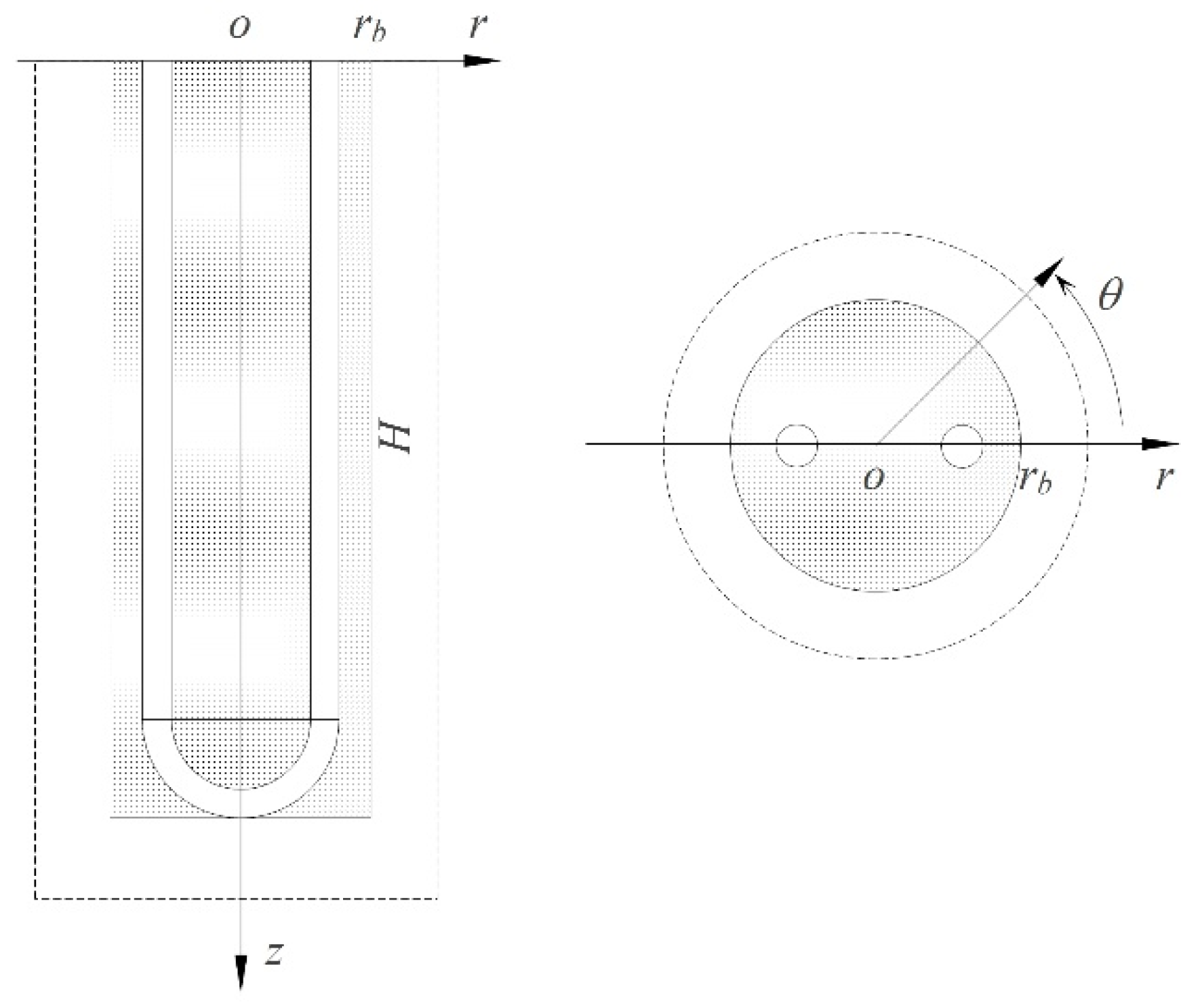
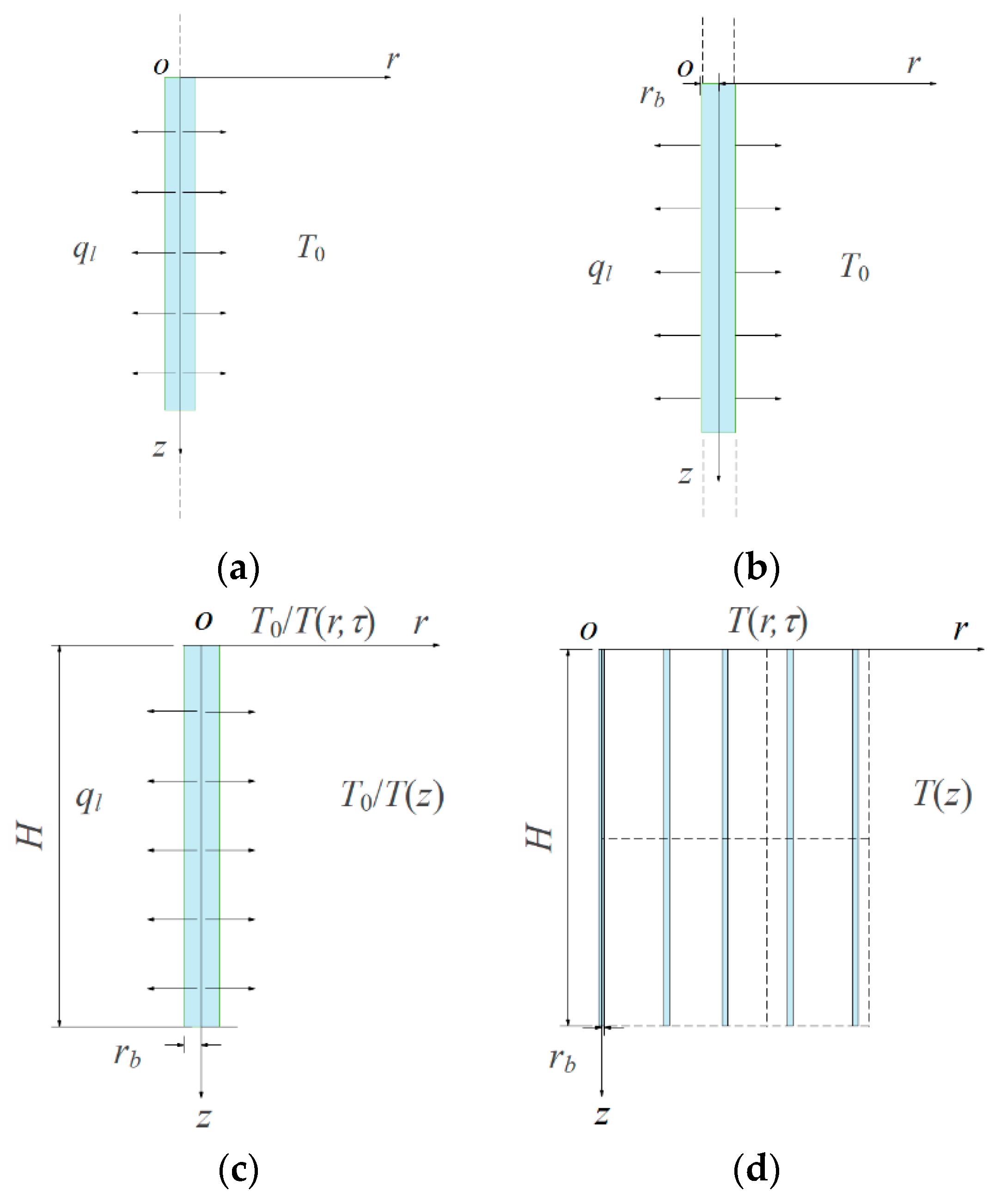
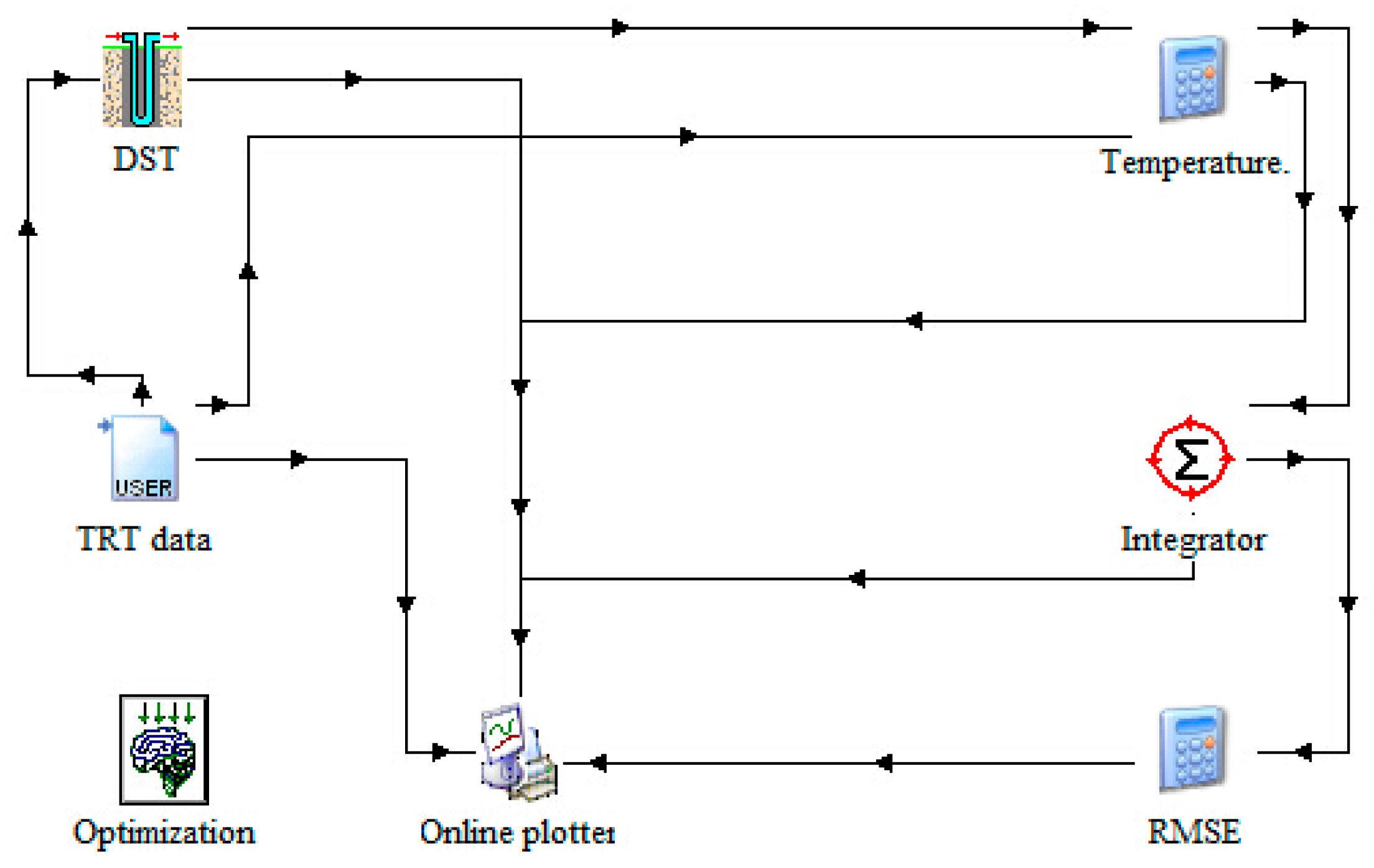

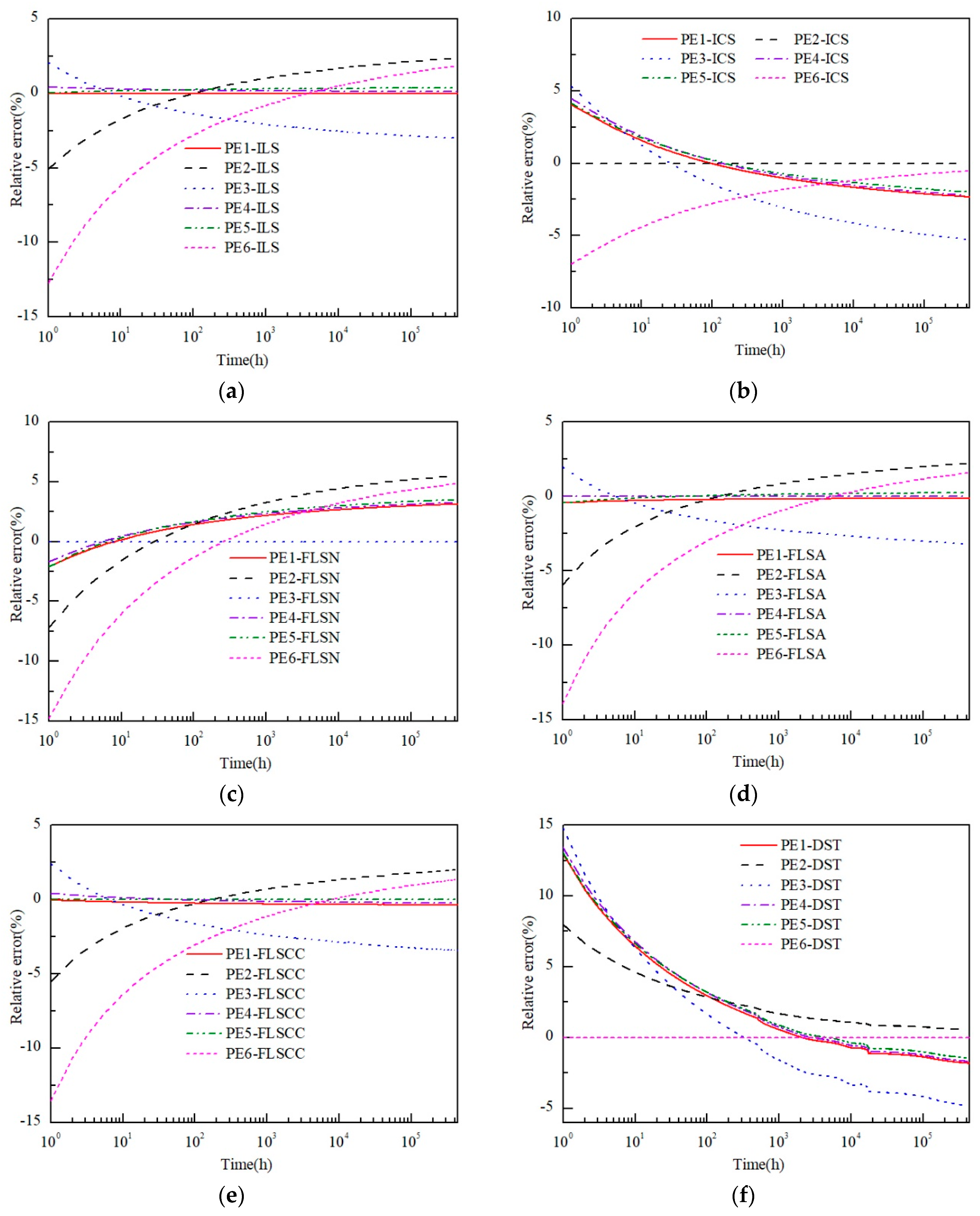
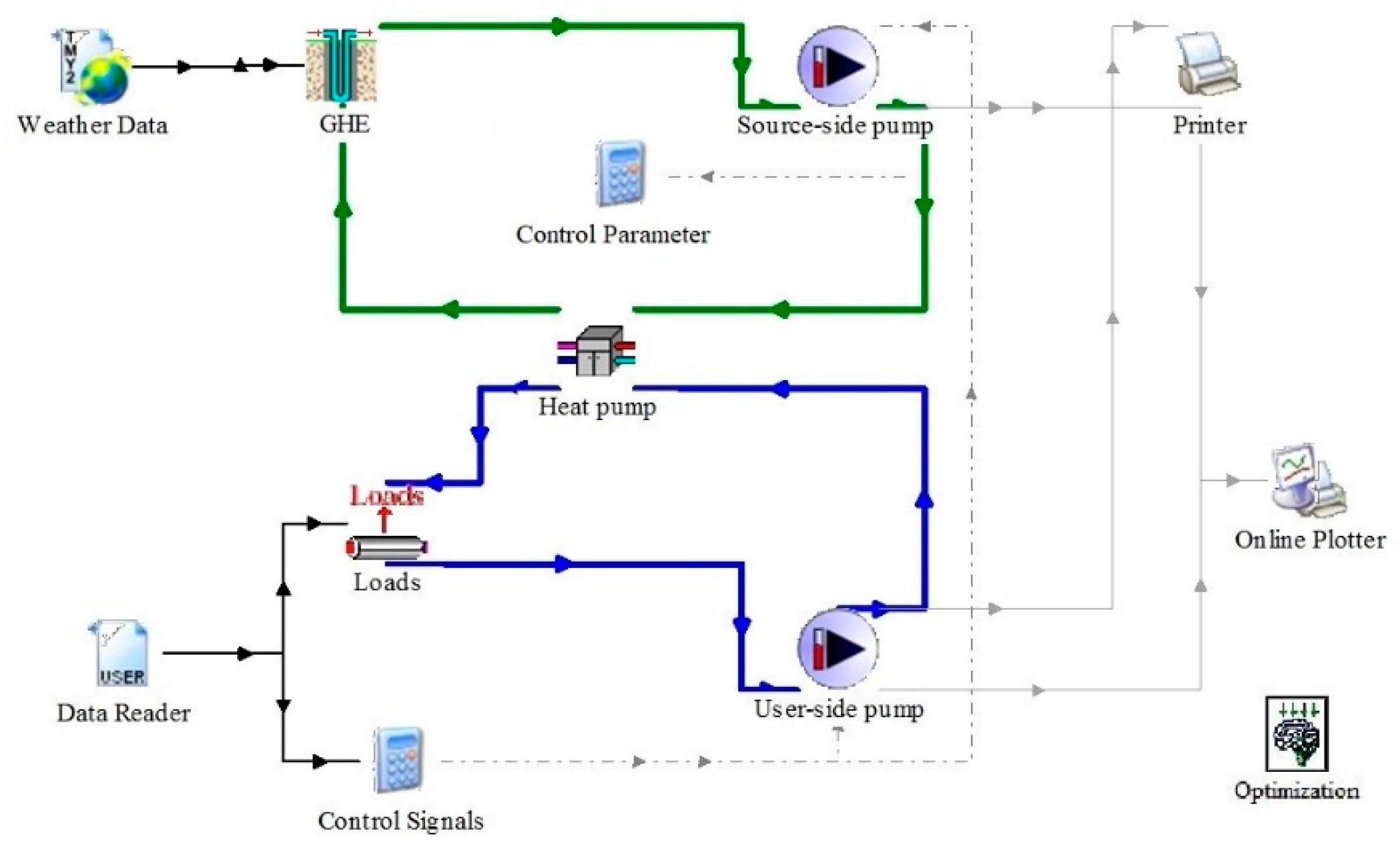



| No. | Base Model | SSE | RMSE (°C) | Rb K·m·W−1 | κs W·m−1·K−1 |
|---|---|---|---|---|---|
| PE1 | ILS | 1.4721 | 0.0975 | 0.0694 | 2.9639 |
| PE2 | ICS | 1.4872 | 0.0980 | 0.0628 | 2.8270 |
| PE3 | FLSN | 1.4794 | 0.0977 | 0.0726 | 3.1102 |
| PE4 | FLSA | 1.4788 | 0.0977 | 0.0698 | 2.9630 |
| PE5 | FLSCC | 0.9872 | 0.0798 | 0.0693 | 2.9496 |
| PE6 | DST | 1.2876 | 0.0914 | 0.0540 | 2.7793 |
| M1 | M2 | M3 | M4 | |
|---|---|---|---|---|
| Type | Simple equation-based | Simple equation-based | Software-based | Software-based |
| Base model | ILS | ICS | FLSCC | DST |
| Load representation | Two pulses | Three pulses | Hourly loads | Hourly loads |
| Bore field geometry | Rectangle | Rectangle | Rectangle | Cylinder |
| COPs | Constant | Constant | Constant | Variable |
| Surface temperature | Constant | Constant | Variable | Variable |
| Thermal inference | √ | √ | √ | √ |
| Geothermal gradient | √ | √ | ||
| Ground stratification | √ | |||
| Thermal insulation | √ | |||
| Thermal short-circuiting | √ | √ |
| Parameter | Symbol | Unit | Value | Application | Source |
|---|---|---|---|---|---|
| Borehole spacing | B | m | 6 | M1, M2, M3, M4 | -- |
| Number of boreholes | Nb | -- | 12 × 12 | M1, M2, M3 | -- |
| Number of U-pipe legs | NUlegs | -- | 2 | M1 | -- |
| Borehole radius | rb | m | 0.076 | M1, M2, M3, M4 | -- |
| Pipe outside radius | ro | m | 0.016 | M1 | -- |
| Pipe inside radius | ri | m | 0.013 | M1 | -- |
| Equivalent pipe radius | roe | m | -- | M1 | Equation (44) |
| Thermal conductivity of pipe | κp | W·m−1·K−1 | 0.70 | M1 | -- |
| Soil density | ρs | kg·m−3 | 2000 | M1, M2, M3, M4 | -- |
| Soil specific heat capacity | cs | J·kg−1·m−3·K−1 | 1125 | M1, M2, M3, M4 | -- |
| Specific heat of the fluid | Cf | J·kg−1·K−1 | 4019 | M2, M3, M4 | -- |
| Soil thermal diffusivity | αs | m²·s−1 | -- | M1, M2, M3, M4 | Equation (4) |
| Soil thermal conductivity | κs | W·m−1·K−1 | -- | M1, M2, M3, M4 | Table 1 |
| Borehole thermal resistance | Rb | K·m·W−1 | -- | M1, M2, M3, M4 | Table 1 |
| Soil thermal resistance | Rs | K·m·W−1 | -- | M1 | Equation (41)–(44) |
| Thermal resistance of U pipe | Rp | K·m·W−1 | -- | M1 | Equation (35) |
| Effective thermal resistances of ground to annual pulse | Rga | K·m·W−1 | -- | M2 | Equation (36) |
| Effective thermal resistances of ground to monthly pulse | Rgm | K·m·W−1 | -- | M2 | Equation (37) |
| Effective thermal resistances of ground to peak daily pulse | Rgd | K·m·W−1 | -- | M2 | Equation (38) |
| Operation time of annual pulse | τa | h | 87,600 | M2 | -- |
| Operation time of monthly pulse | τm | h | 720 | M2 | -- |
| Operation time of daily pulse | τd | h | 6 | M2 | -- |
| Simulation period | τn | h | -- | M1, M2, M3, M4 | Method dependent |
| Net annual average heat transfer to ground | Qa | kW | 31.7 | M2 | Load analysis |
| Design load for cooling mode | Qc | kW | 1030 | M1, M2 | Load analysis |
| Design load for heating mode | Qh | kW | 1030 | M1, M2 | Load analysis |
| Part-load factor for cooling mode | PLFc | -- | 0.17 | M2 | Load analysis |
| Part-load factor for heating mode | PLFh | -- | 0.17 | M2 | Load analysis |
| Run fraction for cooling mode | Fc | -- | 0.50 | M1 | Load analysis |
| Run fraction for heating mode | Fh | -- | 0.50 | M1 | Load analysis |
| Short-circuit heat loss factor | Fsc | -- | 1.04 | M2 | -- |
| Undisturbed ground temperature | T0 | °C | 7.5 | M1, M2, M4 | -- |
| Ground surface temperature at z=0 | T0s | °C | 7.5 | M3, M4 | -- |
| Geothermal gradient | k▽ | °C·m−1 | 0 | M3, M4 | -- |
| Period of temperature oscillations | τpd | s | 3.1536 × 107 | M3, M4 | -- |
| Depth of thermal penetration | dp | m | -- | M3 | Equation (21) |
| Time boundary of unsteady state | τmin | s | -- | M3 | Equation (10) |
| Time boundary of steady state | τss | s | -- | M3 | Equation (11) |
| Maximum heat pump entering fluid temperature | TH | °C | 32 | M1, M2, M3, M4 | -- |
| Fluid temperature entering the heat pump | Tin,hp | °C | -- | M2, M3 | Equation (33) |
| Minimum heat pump entering fluid temperature | TL | °C | 1 | M1, M2, M3, M4 | -- |
| Penalty temperature | Tp | °C | -- | M2 | Equation (45) |
| Annual mean ground surface temperature | Tm | °C | 7.8 | M3, M4 | -- |
| Amplitude of temperature oscillations | Tam | °C | -18 | M3, M4 | -- |
| Initial phase | ω∆τ | rad | 0.24 | M3, M4 | -- |
| Coefficient of performance for cooling mode | COPc | -- | 3.993 | M1, M2, M3 | -- |
| Coefficient of performance for heating mode | COPh | -- | 3.351 | M1, M2, M3 | -- |
| Flow rate | kg·s−1 | 70 | M2, M3, M4 | -- | |
| Flow velocity | υf | m·s−1 | 0.6 | M4 | -- |
| Storage volume | VDST | m3 | -- | M4 | Equation (34) |
| PE1 | PE2 | PE3 | PE4 | PE5 | PE6 | |
|---|---|---|---|---|---|---|
| M1 | 0.00 | 3.07 | 2.99 | 0.02 | 0.96 | 4.21 |
| M2 | 1.36 | 0.00 | 0.83 | 1.60 | 1.54 | 4.09 |
| M3 | 0.00 | 6.27 | 2.47 | 0.45 | 0.00 | 15.64 |
| M4 | 5.64 | 4.14 | 5.38 | 5.96 | 5.81 | 0.00 |
| IGSHPA | ASHRAE | FLSCC | TRNSYS | |
|---|---|---|---|---|
| Average length, m | 138.20 | 190.98 | 76.14 | 64.61 |
| Relative difference, % | 18.12 | 63.23 | −34.93 | −44.78 |
© 2019 by the authors. Licensee MDPI, Basel, Switzerland. This article is an open access article distributed under the terms and conditions of the Creative Commons Attribution (CC BY) license (http://creativecommons.org/licenses/by/4.0/).
Share and Cite
Zhang, X.; Zhang, T.; Li, B.; Jiang, Y. Comparison of Four Methods for Borehole Heat Exchanger Sizing Subject to Thermal Response Test Parameter Estimation. Energies 2019, 12, 4067. https://doi.org/10.3390/en12214067
Zhang X, Zhang T, Li B, Jiang Y. Comparison of Four Methods for Borehole Heat Exchanger Sizing Subject to Thermal Response Test Parameter Estimation. Energies. 2019; 12(21):4067. https://doi.org/10.3390/en12214067
Chicago/Turabian StyleZhang, Xuedan, Tiantian Zhang, Bingxi Li, and Yiqiang Jiang. 2019. "Comparison of Four Methods for Borehole Heat Exchanger Sizing Subject to Thermal Response Test Parameter Estimation" Energies 12, no. 21: 4067. https://doi.org/10.3390/en12214067






